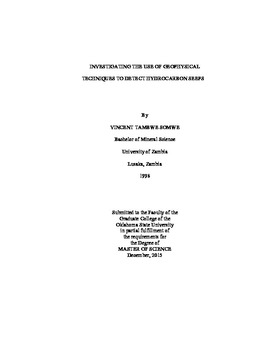| dc.contributor.advisor | Atekwana, Estella A. | |
| dc.contributor.author | Somwe, Vincent Tambwe | |
| dc.date.accessioned | 2017-02-22T22:13:11Z | |
| dc.date.available | 2017-02-22T22:13:11Z | |
| dc.date.issued | 2015-12-01 | |
| dc.identifier.uri | https://hdl.handle.net/11244/49016 | |
| dc.description.abstract | In the Cement oil field, seeps occur in the Hydrocarbon Induced Diagenetic Aureole (HIDA).This 14 square km diagenetic alteration region is mainly characterized by the: (1) secondary carbonate minerals deposition that tends to form ridges throughout the oil field; (2) disseminated pyrite in the vicinity of the fault zones; (3) uranium occurrence and the change in color pattern from red to bleached red sandstone. Generally the HIDA of the Cement oil field is subdivided into four zones: (1) carbonate cemented sandstone zone (zone 1), (2) altered sandstone zone (zone 2), (3) sulfide zone (zone 3) and (4) unaltered sandstone zone (zone 4). This study investigated the use of geophysical techniques to detect alteration zones over the Cement oil field. Magnetic and electromagnetic data were acquired at 5 m interval using the geometric G858 magnetometer and the Geonics EM-31 respectively. Both total magnetic intensity and bulk conductivity were found to decrease across boundaries between unaltered and altered sandstones. Boundaries between sulfide and carbonate zones, which in most cases were located in fault zones, were found to be characterized by higher magnetic and bulk conductivity readings. The contrast between the background and the highest positive peak was found to be in the range of 0.5-10% for total magnetic intensity and 258-450% for bulk conductivity respectively; suggesting that the detection of hydrocarbon seeps would be more effective with EM techniques. The study suggests that geophysical techniques can be used to delineate contact between the different alteration zones especially where metallic minerals such as pyrite are precipitated. The occurrence of carbonate cemented sandstone in the Cement oil field can be used as a pathfinder for hydrocarbon reservoir. The change in color in the altered sandstone zone can still be useful in the hydrocarbon exploration. | |
| dc.format | application/pdf | |
| dc.language | en_US | |
| dc.rights | Copyright is held by the author who has granted the Oklahoma State University Library the non-exclusive right to share this material in its institutional repository. Contact Digital Library Services at lib-dls@okstate.edu or 405-744-9161 for the permission policy on the use, reproduction or distribution of this material. | |
| dc.title | Investigating the Use of Geophysical Techniques to Detect Hydrocarbon Seeps | |
| dc.contributor.committeeMember | Abdelsalam, . Mohamed G. | |
| dc.contributor.committeeMember | Byrnes, Jeffrey M. | |
| osu.filename | Somwe_okstate_0664M_14341.pdf | |
| osu.accesstype | Open Access | |
| dc.description.department | Geology | |
| dc.type.genre | Thesis | |
| dc.type.material | text | |
